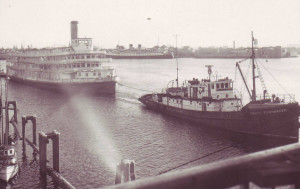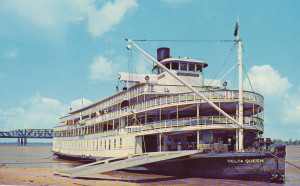S.S. Delta King, King of the Riverboats
In February 2014 it was announced that a Baltic Sea cruise ship, the Silja Festival, was being converted in a Vancouver shipyard to provide living accommodations for as many as 600 construction workers in Kitimat.
Shades of deja vu all over again
In 1959 the old river boat Delta King called at Victoria during what many thought would be her last voyage before the scrapyard. Her (ships are feminine) days of splendour on California’s Sacramento River were distant memories by the time the filthy, paddle-less derelict crept into the Inner Harbour astern of a tugboat, that March evening.
Her tall funnel, a proud standard in happier times, seemed ashamed of its nakedness atop a peeling superstructure which once had gleamed as white and saucy as Scarlett O’Hara’s petticoats.
But more than 30 years had passed since Delta King and sister ship Delta Queen were built in Glasgow, Scotland for the overnight passenger service between San Francisco and Sacramento. The twins had been no ordinary ferries but the largest–285 feet long–and most expensive sternwheelers ever constructed.
Built on classical riverboat lines with romantic paddlewheels, their precision-crafted machinery came from Germany’s famous Krupp Steel Works and they cost $875,000 each with their plush air-conditioned staterooms and saloons that included almost every luxury of that flamboyant era.
They were, in fact, to quote Wikipedia, “the most lavishly appointed and expensive sternwheel passenger boats ever commissioned”.
The long hulls of Swedish steel were built in sections then shipped to Stockton for assembly. For several years, the sisters enjoyed peaceful careers on the Sacramento River, followed by enforced idleness during the hungry ‘30s. In the Second World War they were taken over by the U.S. Navy for service in the Bay City area and never returned to their original roles. Peacetime brought further unemployment then sale.
For Delta Queen, new ownership brought glamour and fame. Again sectioned, she was freighted to the Ohio River, reassembled and placed on the Mississippi River as the last of the big excursion boats, a beautiful memory from one of the most colourful chapters in American history.
The King wasn’t so fortunate.
After years of idleness she was bought in 1952 by the Aluminum Co. of Canada to provide temporary housing for hundreds of workers building Kitimat and “beached within a ingot’s throw of the giant Alcan smelter, [a] ‘home’ for a racial potpourri of construction crews, land clearers, laborers.”
Kitimat Bank manager Hugh Parmiter recalled: “The ‘Thing’ finally arrived from a refit job at Yarrows Shipyard, Esquimalt, after being towed up-coast from California. A level bed had been bulldozed out for it, on the shore…and all awaited the big day of the highest tide in May, when it could be floated into position. The tide elected to arrive at the unseemly hour of 2 a.m., and few saw the fevered activity, the pushing of tugs, aided with cable winches positioned along the upper shore like artillery pieces.
“It was an education to hear the screams and shouts and orders given at one end of the boat and promptly countermanded by another authority at the other end, the flashing arc-lights on shore and boat searchlights on deck…”
There were times when Parmiter considered the King to be more of a curse than a blessing.
“Our sole boast, eventually, was that the D.K. housed the boilers providing steam heat for the Smeltersite School, hospital, recreation hall and Helen’s Café.
“As a personal loss, the big paddlewheel had been removed. I had pictured a gay-appearing boat such as I had known earlier while living in the Yukon, whereas the effect was similar to a rooster minus [its] tail feathers. In addition, outside stairs were added as a fire precaution, and a seawall built to keep out high tides. In time the wall proved necessary, as we found that we were afloat, which broke short connections of water mains and sewers.”
His deepest memory of the King was “not from residence therein, but as a neighbour. During the first summer, to provide steam heat…the boilers developed a terrific thirst for oil, and consumed about 1200 gallons daily. Half of this flew out of the smokestack in waves reminiscent of a ship laying a smokescreen, and our office, directly downwind, was the immediate beneficiary. Each member of the staff carried a duster permanently in the left hand, to wipe a clean spot on which to work, and nary a letter was set out that was not generously smeared with blots of oily soot…”
The King barely escaped disaster within weeks of her arrival when her old boiler caught fire and volunteer fire fighters unknowingly attacked the oil blaze with water.
Almost as miraculously, on a spring day in 1959, she headed for her old home, the Sacramento River, where she was to be restored as a museum, restaurant and theatre. Crowds braved a midnight chill to watch her departure. A dike had been constructed around her basin, then water was pumped in.
Despite her years of inactivity and neglect, the old girl floated slowly and steadily from the mud. Only her rudders had to be freed. When the dike was broken, she answered the towline demurely, floating smoothly into the channel at high tide, to the cheers of those watching.
Back in Victoria, she was boarded up for the final deep-sea voyage to San Francisco. There, parts of her machinery were cannibalized to repair her sister Queen, still in active service at Cincinnati. But the King’s large paddlewheels, kept in storage all those years, were returned to her.
A year later, the refurbished sternwheeler made her movie debut.
Outfitted with dummy smokestacks that belched real smoke, she ‘sailed’ again before the cameras for The Adventures of Huckleberry Finn. Resplendent in new paint, the ‘King’ of the river boats had come home.
The Delta King is permanently berthed at Old Sacramento where, her web site states, she is “beautifully restored and converted to an upscale hotel with a popular restaurant, entertainment, lounge, and meeting and banquet facilities”.



I remember that vessel as my father took me to view it many times in the times before she left!!
Thanks for the comment, Roy. Someday I’ll write about our own riverboats, on the Fraser and the Skeena, etc. Some great stories there, I’ll tell you! –TWP
Have many memories of the Delta King having arrived in Kitimat in 1953 and living there until 1969. In 1987 we were in New Orleans and went for a dinner cruise on the Delta Queen.
Hi, Larry. You got to see the old girl before and after. Neat! –TWP
Thank you so much for your article about the KING. I always enjoy any historic information about these riverboats.
I have been retired now for about eight years. I had the honor to be the Captain of the DELTA QUEEN on the Mississippi river for over thirty years. It was a wonderful career!
I bet you can tell some pretty good yarns yourself of what’s it’s like to be the master of a fine vessel such as the ‘Delta Queen’. Sounds like a boyhood dream come true!
I wish so badly she & her sister the Delta Queen could be running mates again – passing one another on the river blowing a shreek of steam whistle salute to one another…..
One can still dream……
Who knows? Anything can happen……
That goes for me, too, Gene! You’d think that, by now, someone would have a real live riverboat operating as a tourist excursion boat on the lower Fraser. But we don’t do a very good job of preserving our heritage in B.C., alas. They do a much better job of it below the border, though. Happy New Year.
–TW